So, you’ve found yourself leading (or part of a team leading) a marketing agency! And now you’re realizing that your gut feelings, approximations, and intuitions can only get you so far – most notably when it comes to sustainably scaling your agency.
Worse still, even the simplest questions can feel tricky to answer at times. Questions like “Was this project profitable?” and “Do we need to hire another PPC specialist or designer and when?”
It’s OK, you’re not alone. It’s a classic growing pain we repeatedly see in digital marketing agencies, which can be solved by adding structure to your decision-making process and tracking key metrics.
The question boils down to this: What do you measure, and how do you measure it?
Why Agency Metrics Matter
Don’t get me wrong; you can definitely get an agency off the ground utilizing those gut feelings, especially when other facets of your business check out – such as your positioning, sales & pricing. However, there comes a time when you’re going to hit that ceiling (if you’re reading this, you’ve likely bonked your head on it already). Consider it a turning point, resulting in key data-driven decision-making to mitigate growth from breaking your business.
Decisions driven by data will always be more reliable for your agency. Data tells your story. Listening to what it has to say will allow you to directly utilize your agency’s experience (past projects and clients) to forecast/estimate future project profitability, capacity, and overall success.
The ability to make sound predictions about client work lays the vital foundation for scalable agency operations. Think about it; forecasting almost anything in an agency – from people to cash and profits – almost always reverts to relying on solid estimates regarding the time, effort, and money required to execute for clients. Getting this right means a more profitable business, but also should mean fewer surprises that end up causing timeline crunches, overtime work, and burnout.
Ready to turn data into better decisions? Book a free strategy call to learn how we help agencies forecast and grow with clarity.
Agency Metrics and KPIs You Should Be Tracking
Hopefully, at this point, we’ve done a capital job convincing you that your data can be a reliable indicator of your agency’s success. So, what next? What exactly should you be tracking? What are the key metrics for seeing how well (or poorly) your agency is performing?
We’ve broken it down into two key indicators: Core Financials and Non-Financial Reporting. Within these indicators, we’re going to show you how to measure the most important aspects of your agency and make better decisions using data.
Core Financials
- Agency Gross Income (AGI)
- Delivery Margin
- Overhead Spending
- Operating Profit
Non-Financial Metrics
- Average Billable Rate
- Utilization
- Scoping Accuracy
- Forecasting
Core Financials
Core financials, such as bookkeeping and accounting services, are probably your agency’s lowest hanging fruit in terms of indicators. A few simple tweaks here can unlock A LOT of important insights. Here are some of the key values you can glean from your agency P&L.
1. Agency Gross Income (AGI)
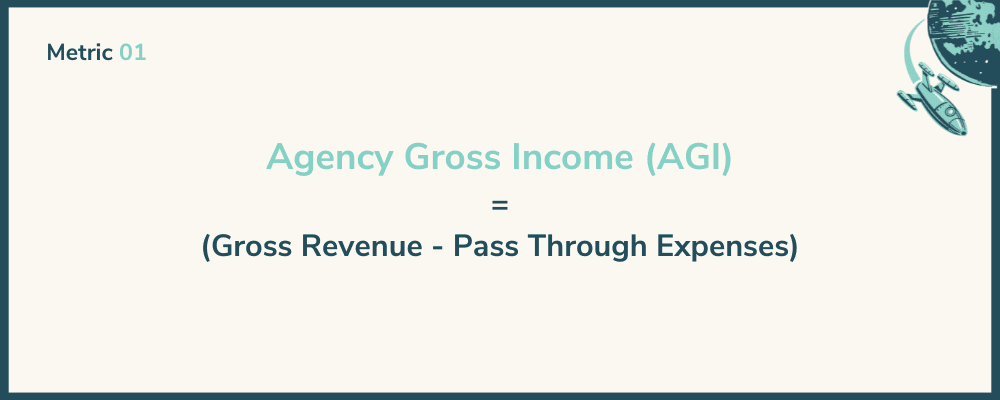
AGI is the total amount of money that comes into your agency (Gross Revenue) minus your Pass-Through Expenses (often, your accountant will consider these COGS).
Pass-Through Expenses are those in which external vendors are required for delivering work to end clients. Revenue that passes through the business and onto other vendors is not the business’s responsibility to earn with their own time and effort.
Examples of Pass-Through Expenses include:
- Print Budgets, Ad spends, Media Buy
- Anything White-Labeled (video production, etc)
- Hiring Freelancers/Contractors to provide services that are not core to your business
- Other materials that are specific to that project – like stock footage, website templates, WordPress plugins, client-specific software or hosting fees, etc.
Benchmarks
To be honest, there aren’t really any benchmarks for AGI vs Revenue. We’ve worked with clients that have no pass-through expenses at all, and some that let over 50% of their revenue pass through to other vendors. What’s really important is how profitable the AGI that’s left over is. Everything else is a business model decision. In fact, some of the most profitable agencies we’ve ever audited had substantial amounts of pass-through revenue going to Whitelabel vendors.
Calculation
AGI = Gross Revenue – Pass Through Expenses
2. Delivery Margin
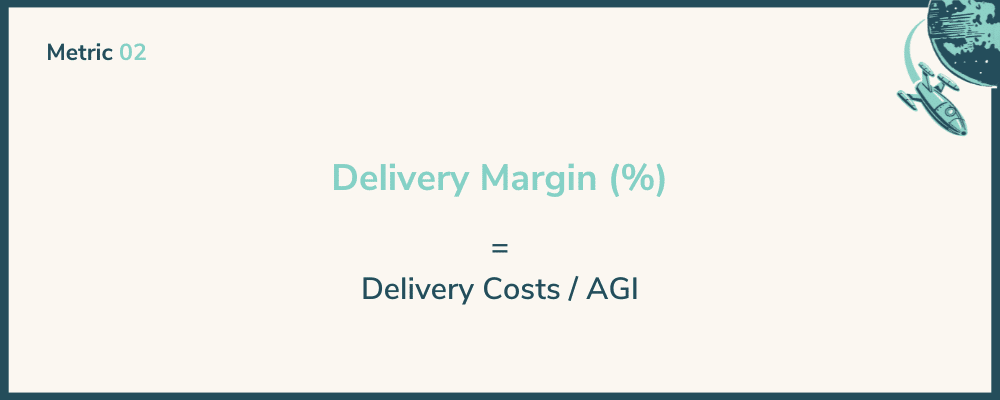
Delivery Margin tells you how efficiently your business is earning its revenue. We ascertain that margin by subtracting your Delivery Costs from AGI, which is the cost of the time and resources required in order to execute work for clients. This may be referred to as Gross Margin or Contribution Margin by accounting professionals.
Examples of Delivery Costs include:
- Payroll for team members doing client work
- Freelancers/contractors that are brought in to do work that is core to the business, or add extra capacity when you run out of it internally.
- Shared delivery costs like software licenses or stock footage libraries that are not specific to one client, but are required to enable the delivery team to do their jobs.
Benchmarks
Ideally, delivery margin should land around 60-70% of AGI on a per-project basis, and 50%+ on your profit and loss statement for the entire agency. Delivery Margin will often be 10-20% lower on an agency-wide basis compared to individual projects – after accounting for gaps in utilization, shared delivery expenses, plus other expenses and inefficiencies often not measured on a per-project basis.
This is easily the most important metric agencies should be measuring. Without healthy delivery margins, it’s extremely difficult to be profitable.
Calculation
Delivery Profit ($) = AGI – Delivery Costs
Delivery Margin (%) = Delivery Costs / AGI
3. Overhead Spending
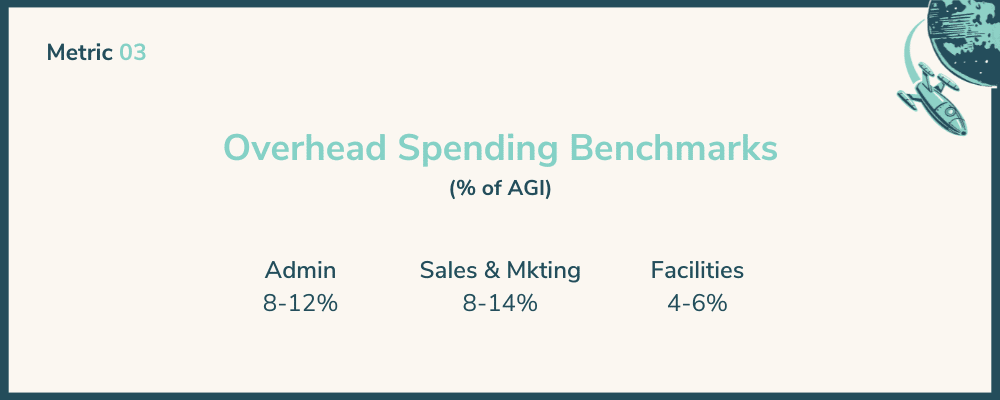
Overhead spending is exactly what it sounds like! It’s the money required to run the business while funding activities. Such activities include Sales & Marketing, Administration, and providing a working environment for your team. This is often where the bulk of your founder salaries will go, along with other often necessities like Rent, Utilities, Advertising, Accounting & Legal, etc.
Benchmarks
We tend to break Overhead Spending (AKA Operating Expenses) into three categories:
- Administration (generally budgeted at 8-12% of AGI)
- Legal, accounting, QBO subscriptions, postage, etc.
- Sales & Marketing (generally budgeted at 8-14% of AGI)
- S&M is any expense related to bringing business into your agency (acquisition cost).
- New Business Development, Salaries for S&M, CRM tools, ad spend, sponsoring events, etc.
- Facilities (generally budgeted at 4-6% of AGI)
- Working environment, rent, utilities, etc.
Total spending on Overhead (i.e. cumulative spending across Admin, Sales & Marketing, and Facilities) should generally fall at around 20-30% of AGI. Where exactly on that spectrum an agency should fall will generally depend on the context of your business. For example, is your workforce largely remote or in-house? Additionally, how much of your team is Freelance or Full-Time? To help decipher your employee cost per hour, check out this handy resource.
Bear in mind, with healthy Delivery Margins (i.e. 50%+) the amount spent on Overhead – and therefore the profitability of the business – is a decision usually made by management. It’s acceptable to consciously over-spend on things like Sales & Marketing, or a fancy office, so long as it’s a deliberate decision. It should be well understood that it’s borrowing from the bottom line to invest in future growth.
4. Operating Profit
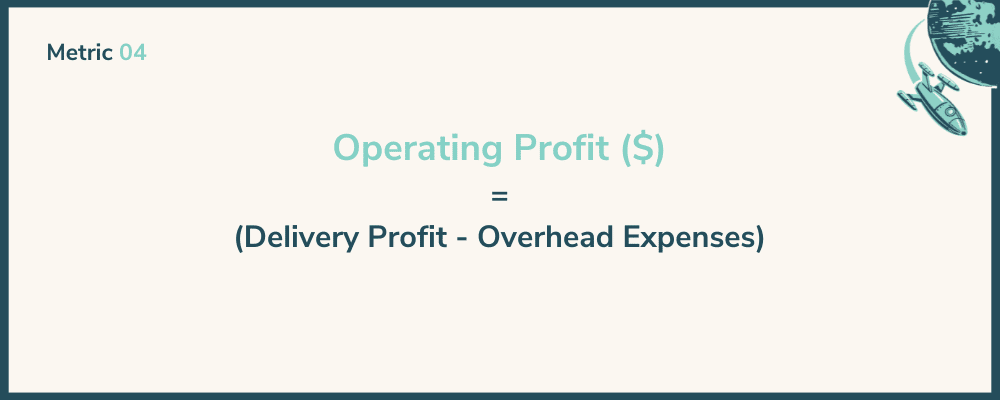
Operating Profit is the dollar amount left over from operations after expenses – but before Interest, Depreciation, Amortization and Taxes. On a standard P&L, the Operating Profit amount may also be called Net Income, Income from Operations, or EBITDA. Operating Profit measures the percentage of profit generated by operations relative to AGI and is a good indicator of the ability for the business to generate free cash flow.
Benchmarks
Most agencies achieve around a 10-15% Net Margin. Our target for clients tends to be 25-35% with 25% being the standard benchmark. Operating Margin is calculated as Operating Profit divided by AGI.
Calculation
Operating Profit ($) = Delivery Profit – Overhead Expenses
Operating Margin (%) = Delivery Profit / AGI
Core Financial Pitfalls…
Financials are extremely precise and useful for periodic checks on the business. However, they lack a few important characteristics that can make them useful in the day-to-day operations of the business.
It has often been thought that financials and the finance department are the answer to agency profitability measurement. And why that might be true for the absolute values, financials (in our opinion) are just one small piece of the puzzle when it comes to a high-performing agency operations data system.
- The biggest pitfall with financials is that they tend to be slow and retroactive. By that, we mean most companies aren’t getting reconciled financials until 15 or 20 days after month-end. In other words – by the time they’re looking at this data, it can be almost 2 months old.
- The other challenge is the cost of additional depth, precision, or speed. The amount of time (and often accounting costs) plus the precision required at the invoice, expense, and payroll allocation level can be exponential. And that’s before you tackle department, client, project, phase, or even role-based performance measurements. The cost of increased measurement to obtain more timely data comes down to more frequent and finessed bookkeeping which can come at a significant cost.
- The final important challenge is that financially based metrics can be challenging to use for empowering the broader team to make decisions. Many owners are weary of exposing financials to their broader team, and many team members lack the financial literacy and/or context to properly interpret this data.
This is why we highly recommend using a few very simple and inexpensive “non-financial” marketing agency metrics in combination with financial metrics. This results in more frequent touchpoints on performance alongside an ability to readily start forecasting into the future.
Non-Financial Metrics
5. Average Billable Rate
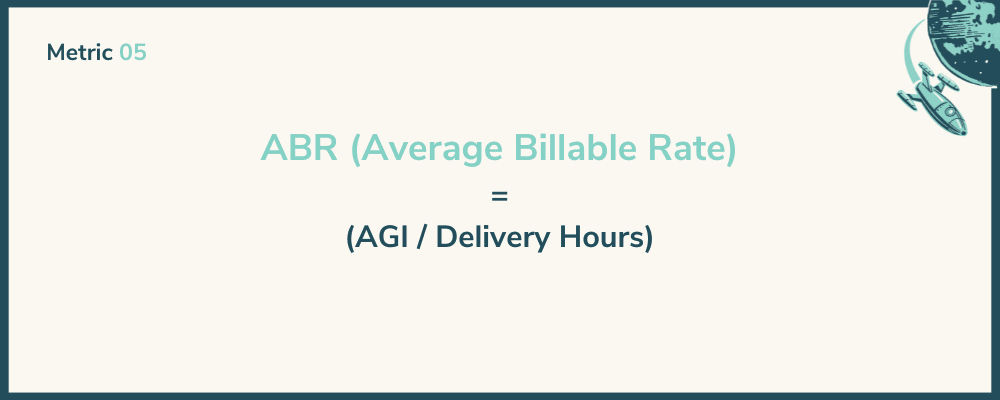
Average Billable Rate (ABR) is a fast and simple non-financial metric, which can be used as a more timely and less expensive proxy for delivery margin. Most notably, ABR can measure the earning efficiency of any time period and/or slice of the agency for which you have two simple pieces of information: AGI and Hours. For example, you could decide to compare ABR across all your website projects in the last 6 months. Let’s break it down!
Ingredients
- Agency Gross Income for a given time period or slice of the business
- Delivery hours worked against that AGI
Formula
AGI / Delivery Hours
Example
Comparing our 3 projects from last month.
- Project 1:
$75,000 / 1260 hours = $59.52 ABR - Project 2:
$50,000 / 580 hours = $86.20 ABR - Project 3:
$60,000 / 425 hours = $141.17 ABR
ABR Benchmarks
- Benchmarks for ABR are the same as for Delivery Margin. Generally, you want the “Margin” between your Average Cost Per Hour and your Average Billable Rate to be at least 60-70%.
- For example, if your average cost per hour is $45 and you’re aiming for a 70% margin, your ABR target would be at least $45 / (1 – 0.70) = $150
6. Utilization
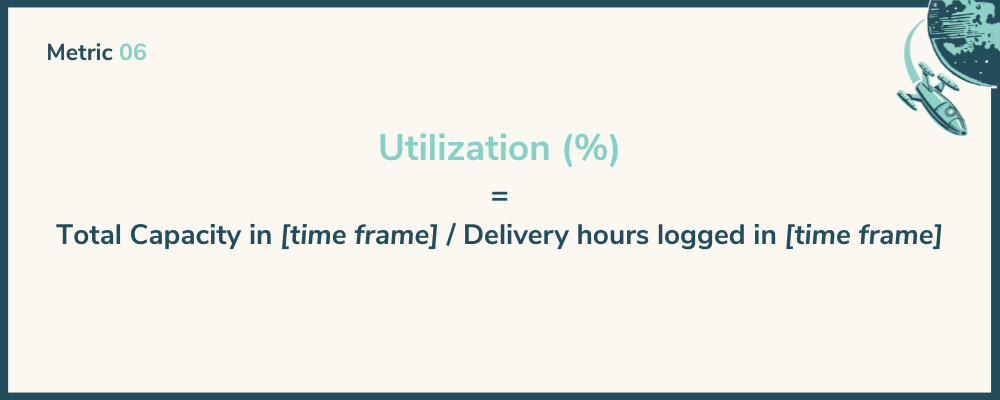
Utilization is critical to in-house teams that depend on productivity for agency profitability. Essentially, it measures the total number of hours you’re buying from various team members, and how much is being deployed against things that earn revenue for the business (how much of their time is being spent on client work).
Ingredients for your Utilization rate
- Total Capacity: This is all of the time, contractually agreed upon, between team members and the agency. It includes vacation time, sick leave, paid time off, delivery hours (time spent on client work), and non-delivery time (time not spent on client work).
- For example, a full-time employee probably has an employment contract for a 40-hour week, 52 weeks per year, giving them a total capacity of 2,080 annual hours. Multiply that by however many team members you’ve got, and that is your total capacity.
- Delivery Hours (AKA Billable Hours): This would be the time your team spends completing client work. It doesn’t matter if this impacts how the client is billed, or the cost to the client, the only point of importance is the time required to deliver the promised outcome.
- For example, your designer may have logged 1,350 hours towards client deliverables in a given year.
Example
Using the above example of 1,350 hours; let’s say you’re running an agency with one employee. Your Total Capacity as we calculated is:
Total Capacity in Period / Delivery hours logged in Period
2080 / 1350 = 64.9%
Utilization Benchmarks
As for your targets – from a weekly standpoint, you’re going to want your “producers” (designers, developers, copywriters) anywhere from 75-90% utilized from a weekly standpoint. On an annual basis, those “producers” should land between 65-80%. Other roles will have wide-ranging utilization rates, project and account managers for example might be anywhere from 25-75% utilized in a given week, other people like sales or operations managers may not be utilized at all.
Zooming out, the entire business should be able to achieve a utilization rate of 50-60% or more on an annual basis when considering everyone on the team, including non-billable staff. With more than half of payroll being deployed against revenue, there should be enough efficiency to be profitable so long as Average Billable Rates are reasonably healthy.
Interested in seeing how changes in Utilization will impact your agency’s profitability?
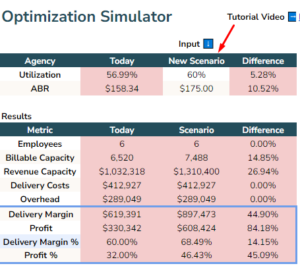
Agency Optimization Simulator from Parakeeto’s Agency Profit Toolkit
All of this for free, and more. Get your copy for free:
**Important Note:
It is of critical importance to measure Utilization alongside an earning efficiency metric, such as Delivery Margin or ABR. As a reminder, ABR goes down as more hours are logged to earn the same amount of revenue. Focussing on increasing utilization, without paying attention to ABR, can lead to counter-productive outcomes whereby the team simply spends more time getting the same amount of revenue earned for the business. Increases in utilization are only valuable to the business as long as they are being achieved with healthy Average Billable Rates.
7. Scoping Accuracy
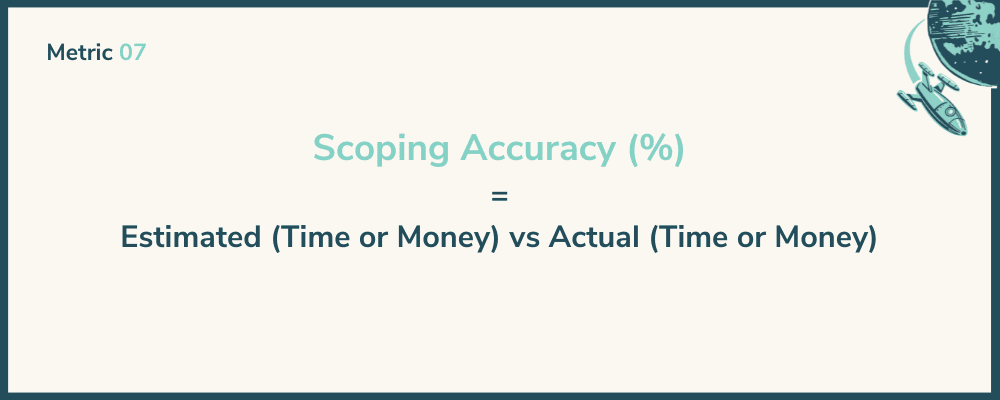
How accurate are your estimates, especially if you compare them to actuals via a retrospective lens?
Ingredients for Scoping Accuracy
Estimated Time & Cost vs Actual Time & Cost
Simply put; where Estimated Time & Cost is the amount of time or money we estimated it would take to complete the work, the Actual Time & Cost is the amount of time or money we actually spent to complete the work.
Formula
Estimated (Time or Money) vs Actual (Time or Money)
Example
Let’s say you’ve got a website design project that you’ve already delivered to a client.
You open up your internal spreadsheet to see you originally scoped this project at 20 hours of ‘Design’ time, and 5 hours of ‘Project Management time. Then, you open up your time-tracking tool only to see 25 hours logged under ‘Design’ for this project and 2 hours logged under ‘Project Management’ time.
Therefore, your total project estimation is: Estimated (25) / Actual (27) = 0.92 (or 8% variance)
Benchmarks
This variance of 8% is more or less expected, and well within the healthy range of 20%. Of course, going over is more concerning than staying under budget – although, variance is variance!
In the big picture, the objective should be to get to a margin of error of around 10% consistently. This should become achievable over time as we collect more data and install more processes to close the gaps between our assumptions and reality – thereby creating your own agency profitability flywheel.
Of course, this is important for protecting margins, but where it becomes even more important is in the context of resource planning & forecasting. Having a low margin of error on project estimates is the single most important element to creating scale and forward visibility around resource planning, timing new hires, and really helps prevent overtime hours from being needed to get things done.
8. Bonus: Forecasting
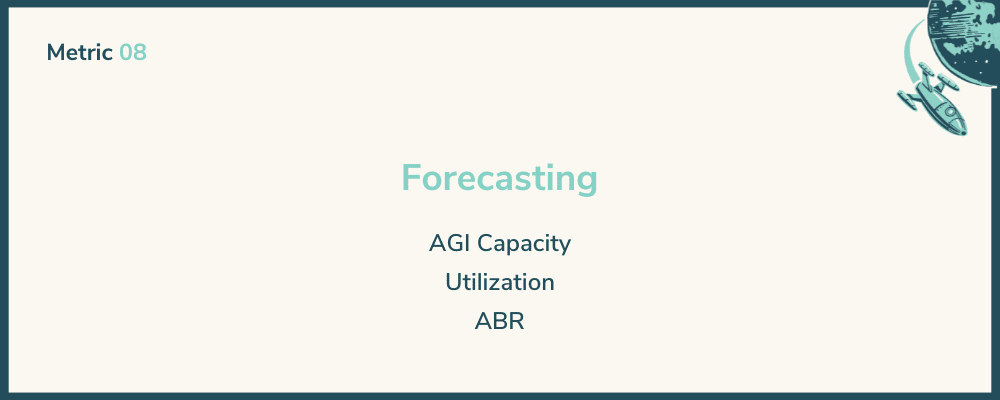
While we can’t quite give you a crystal ball, we can get close enough thanks to some simple techniques to help you see what’s coming down the line and how to act accordingly.
Forecasting Capacity, Utilization & Average Billable Rates
When it comes to looking forward, things become a little (or a lot) more nuanced. There could easily be a whole separate blog post (and there probably will be) on forecasting Capacity, Utilization, and ABR.
Using these simple building blocks increases insight into the future of your business, thus gaining directional accuracy and more informed decision-making.
In the spirit of keeping things simple, here are a few straightforward forecasting formulas you could run using these metrics:
Forecasting Capacity / Utilization
Calculation:
Utilization = Planned Delivery Hours / Planned Capacity
Purpose:
As new projects roll into the pipeline, this can provide a high-level, top-down look at how busy your team will be in the future. The more detailed your ability to break down estimates and capacity, the more granular this top-down forecasting approach can be. For most of our clients, this is done at the agency-wide/role-category level (example: Design, Development, PM, Strategy)
Forecasting AGI Capacity
Calculation:
AGI Capacity: Capacity x Utilization Target x ABR
Purpose:
This can provide high-level insight into how much revenue your business is capable of earning in a given time period based on utilization targets, available capacity, and Average Billable Rate.
This can also be broken down more discretely by department, team, or discipline.
Forecasting ABR or Delivery Margin:
Calculation:
ABR = Planned AGI / Planned Delivery Hours
Purpose:
Producing an in-depth look into what kind of ABR you can expect from upcoming work – based on estimates. Of course, this number will only ever be as reliable as your estimates (yet another incentive to get really good at your scoping work!)
Like other metrics, this one can be broken down more independently by department, team, or discipline. Combined with an average cost-per-hour, delivery margins can also be forecasted.
Suggestions for Keeping Track of Your Agency Metrics & KPIs
- Start with strategy: It’s important to explore this path with clarity around the questions and conversations supported by this data. This will help inform you of a number of facets, such as the right level of precision for a given metric; how often it needs to be measured; and what estimation, time tracking, and capacity modeling need to look like in order to return data that is properly structured. Only then will you have the insights necessary to answer pivotal questions.
- Keep things simple: It’s easy to get carried away, trying to measure everything simultaneously. We recommend you start by nailing your Core Financials, then introducing Non-Financial Metrics at a very high level, before slowly increasing the frequency and precision with which you measure said metrics.
- Precision vs Accuracy: Sadly, being more precise does not always mean being more accurate. The more complex you make things, the exponentially harder it is to track. Therefore, your accuracy will quickly diminish.
- Use an ETL Approach: ETL stands for Extract, Transform, Load. Far too frequently we see clients attempting to entirely automate reporting by piping data from time tracking or project management tools – directly into a dashboard. Unfortunately, this assumes perfection and consistency on all the data being put into those tools. For context; this has literally never been the case with any of our clients. Ever.
Therefore, we believe the best practice is to give yourself a layer, a buffer if you will, to ensure your data is clean, consistent, and well structured – before piping it into a reporting environment. This additional step leads to both increased reliability, and more Change-Proof reporting, as data inputs and outputs can be modified without undermining the existing data and reporting system.
What Now?
Now that you’ve read this blog post, what are the next steps you should pursue from here?
It’s important to acknowledge that agency KPIs don’t have to be complicated. You can gain increased insights with some simple tweaks to the way your financials are set up, and much more frequent visibility with those two simple numbers gleaned via ABR and Utilization.
It’s all too easy to fall into the trap of trying to make these numbers extremely precise and granular, so keeping things simple can provide considerable clarity with minimal overhead and effort. A little visibility can go a very long way in helping inform better, more timely decisions, thus keeping the business profitable and healthy.
Additionally, if you’re interested in working with our team of consultants to measure and improve your agency’s profitability, simply make you’re way here to apply for a consultation!
Agency Profitability Tool Kit
If you’re looking for more resources to help you improve your agency’s profitability, check out the Agency Profitability Tool Kit. It’s full of templates and checklists used when consulting clients. This helps them improve profitability by over 100% in under 60 days.

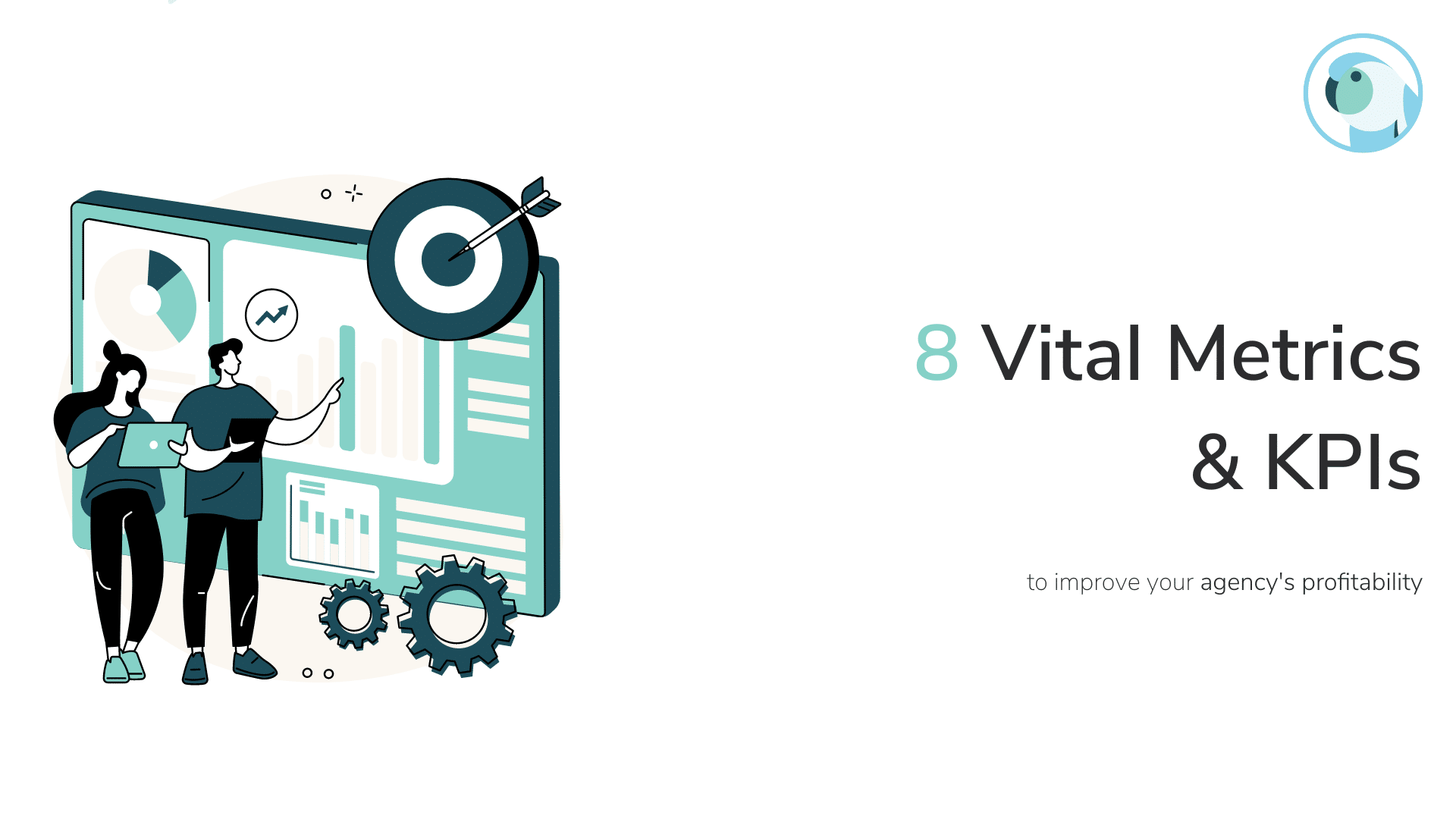


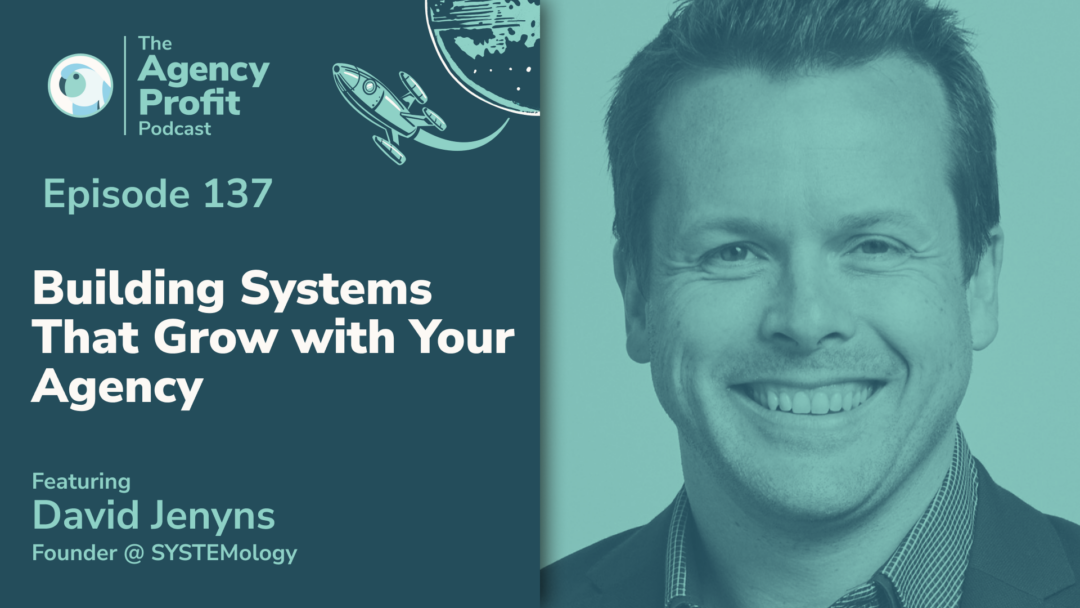

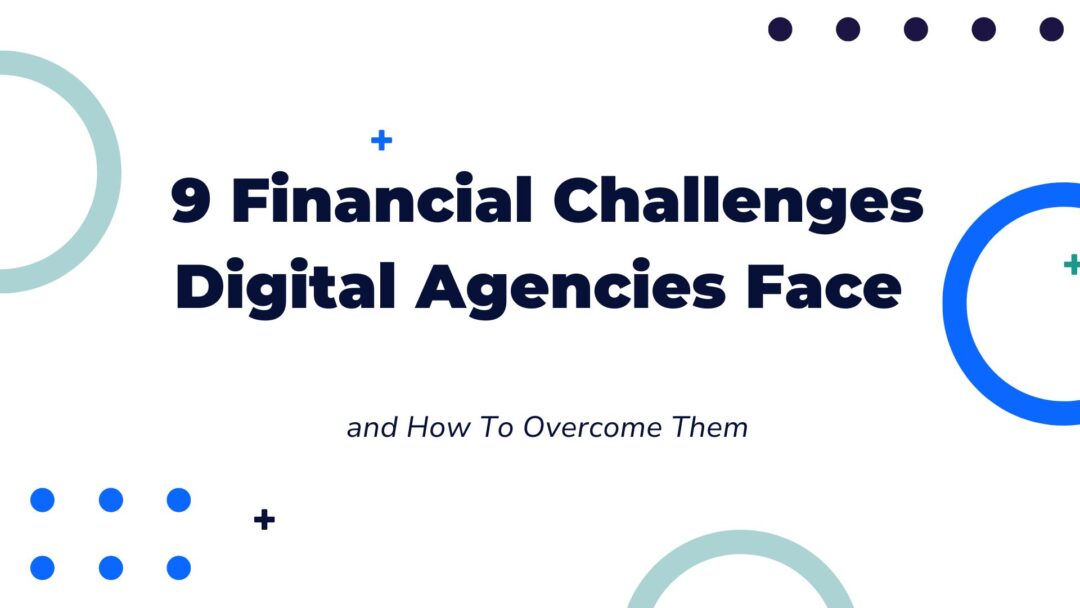

0 Comments